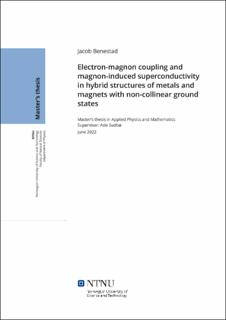| dc.contributor.advisor | Sudbø, Asle | |
| dc.contributor.author | Benestad, Jacob | |
| dc.date.accessioned | 2022-09-01T17:21:06Z | |
| dc.date.available | 2022-09-01T17:21:06Z | |
| dc.date.issued | 2022 | |
| dc.identifier | no.ntnu:inspera:115383357:36605066 | |
| dc.identifier.uri | https://hdl.handle.net/11250/3015244 | |
| dc.description.abstract | Elektron-magnon interaksjoner i et dobbeltlag av monoatomisk metall og en ferromagnetisk isolator med ikke-kolineær spiralfase er studert på et triangulært gitter, motivert av nylig interesse i liknende systemer med enklere kolineære magnetiske lag. Med dette formål presenteres et rammeverk for å beregne kobling mellom elektroner og ikke-kolineære spin, som er en modifisering av eksisterende teori for kolineære spinstrukturer basert på en kanonisk transformasjon til en effektiv Hamilton-operator. Dette er gjort ved å ta i bruk Fishman og Haraldsen sin generelle rotasjonsmodell for ikke-kolineære spinstrukturer. Systemets egenskaper som en ukonvensjonell magnon-formidlet superleder er undersøkt, med en analyse av hvordan "squeezing" av magnonene fra den valgte spinstrukturen påvirker styrken av BCS par-dannelse og hva slags type symmetrier man kan forvente å finne for den superledende tilstanden. Dobbeltlaget som har en en ferromagnetisk isolator med ikke-kolineær spiralfase finner vi at kan ha p-bølge superledning i teorien, men forventer at styrken på BCS interaksjonen blir mindre enn for tilfellet med en kolineær ferromagnetisk isolator. Den lineæriserte gaplikningen ble løst nær Fermiflaten for et approksimert potensial, og en analyse ble forsøkt for en fullstendig beregning over hele første Brillouinsone, men oppløsningen i k-rom ble for lav. Derimot var det interessant å observere at det dukker opp interaksjons-termer i Hamilton-operatoren for spredning av elektronpar uten spinflip som et resultat av den ikke-kolineære strukturen, hvilket kan gi opphav til Sz=±1 polariserte Cooper par. Slike polariserte Cooper par har interessante bruksområder i spintronikk, og selv om de upolariserte parene dominerer for eksempelet studert i denne masteroppgaven kunne man tenke seg at det finnes andre strukturer der de polariserte parene spiller en viktigere rolle. Ideene fra rammeverket presentert i denne oppgaven kan med litt arbeid generaliseres for å studere mer kompliserte 3D spinstrukturer. | |
| dc.description.abstract | Electron-magnon interactions in a bilayer of monoatomic metal and a non-collinear spiral phase ferromagnetic insulator are studied on a triangular lattice, motivated by recent interest in similar systems with simpler collinear magnetic layers. To this intent, a framework for treating coupling between electrons and non-collinear spins is presented by modifying existing theory in the case of collinear spin structures based on a canonical transformation to an effective Hamiltonian. This is achieved using Fishman and Haraldsen's general rotation model for non-collinear spin structures. The system’s properties as an unconventional magnon-mediated superconductor are investigated, with an analysis of how magnon squeezing from the chosen spin structure affects the BCS pairing strength and what type of symmetries one could expect to find for the superconducting state. With the spiral phase ferromagnetic insulator, the bilayer is found to in theory host p-wave superconductivity, although evidence suggests the BCS pairing strength will be weaker than in the case of a collinear ferromagnetic insulator. The linearised gap equation was solved close to the Fermi surface using an approximated potential, and an analysis across the whole first Brillouin zone was attempted but the k-space resolution was deemed insufficient. However, an interesting observation is the appearance of interaction terms in the Hamiltonian that could facilitate electron pair scattering without a spin flip as a result of the non-collinear structure, giving rise to Sz=±1 spin polarised Cooper pairs. Such spin polarised Cooper pairs have interesting applications in spintronics, and while unpolarised terms seem to dominate in the example studied in this thesis there could exist other non-collinear magnetic structures where the polarised pairs play an important role. The ideas of the framework presented here can with a bit of effort be extended in order to perform an analysis of more complicated 3D magnetic structures. | |
| dc.language | eng | |
| dc.publisher | NTNU | |
| dc.title | Electron-magnon coupling and magnon-induced superconductivity in hybrid structures of metals and magnets with non-collinear ground states | |
| dc.type | Master thesis | |
